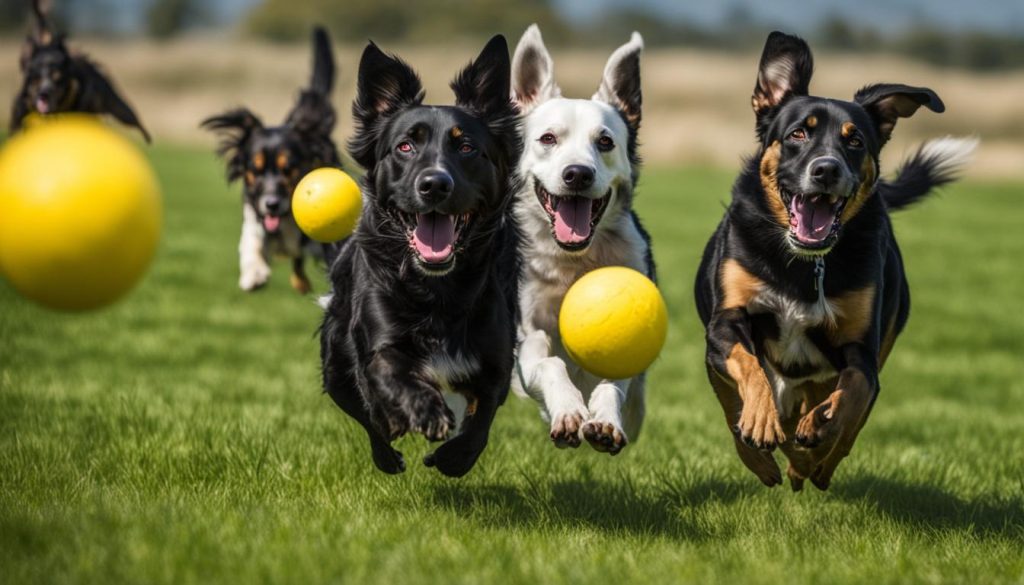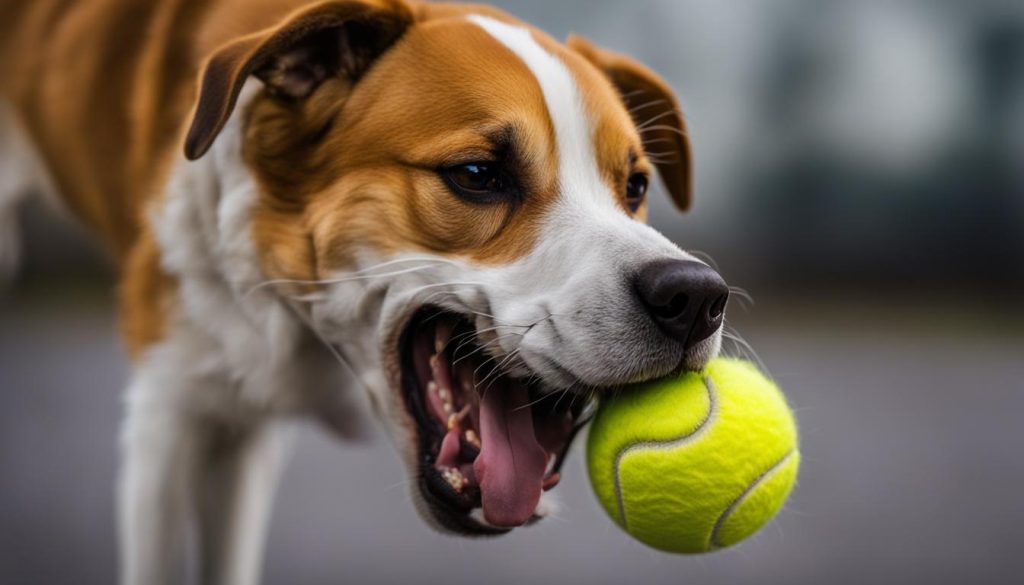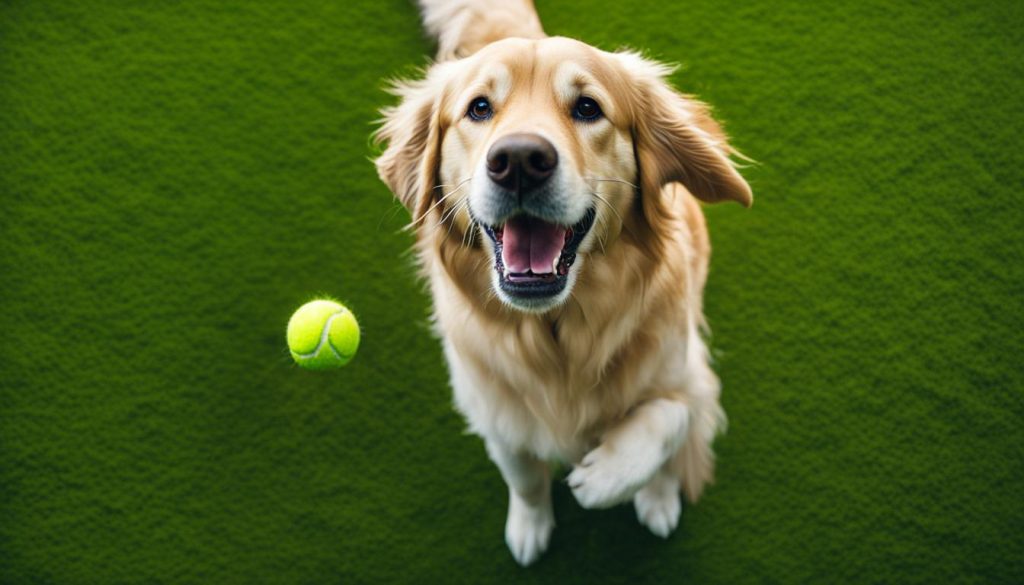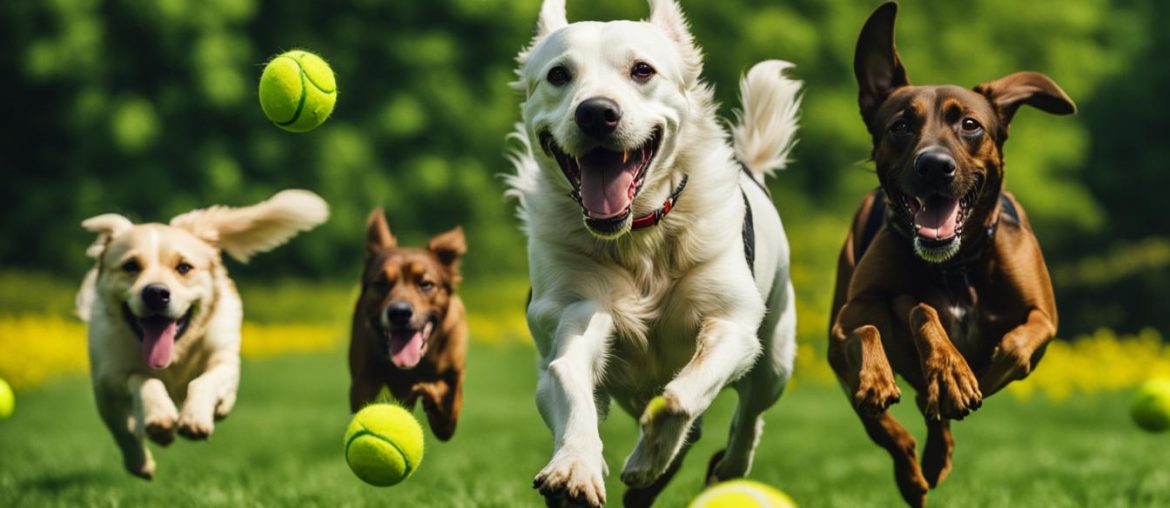Tennis balls are a source of endless fascination for dogs, providing them with hours of joy and entertainment. But have you ever wondered why dogs are so enamored with these bouncy toys? There are several reasons behind their love for tennis balls.
First and foremost, dogs have a natural instinct to chase and retrieve, which stems from their ancestral past as hunters. The erratic movements of a tennis ball mimic the movements of prey, triggering a dog’s hunting instincts and giving them a sense of purpose and excitement.
Furthermore, playing fetch with a tennis ball stimulates the reward centers in a dog’s brain, releasing feel-good chemicals like endorphins and dopamine. This not only creates a positive association with the ball but also provides a sense of satisfaction and contentment for the dog.
In addition to the mental stimulation, the vibrant colors of tennis balls, primarily blue and yellow, stand out to dogs with their dichromatic vision. These colors catch their attention and enhance their engagement during play.
Chewing on tennis balls is another aspect that dogs enjoy. It satisfies their need to gnaw and chew, promotes dental health, and provides a sense of comfort and relaxation.
Tennis balls offer a combination of physical activity, mental stimulation, and emotional satisfaction for dogs, creating a strong bond between them and their favorite toys. It’s no wonder dogs can’t get enough of tennis balls!
Key Takeaways:
- Dogs love tennis balls because they trigger their natural hunting instincts.
- Playing fetch with tennis balls stimulates the reward centers in a dog’s brain, releasing feel-good chemicals.
- The vibrant colors of tennis balls stand out to dogs with their dichromatic vision.
- Chewing on tennis balls satisfies dogs’ urge to gnaw and chew while promoting dental health.
- Tennis balls offer a combination of physical activity, mental stimulation, and emotional satisfaction for dogs.
The Instinctual Drive to Chase
Dogs have a strong prey drive, which is why they are instinctively drawn to chasing moving objects. This prey drive stems from their ancestral past as hunters, where they would chase and catch prey. Chasing a tennis ball mimics the movements of prey, triggering a dog’s natural hunting instincts. When a dog successfully catches a moving target like a tennis ball, it stimulates the reward centers in their brain, releasing feel-good chemicals and reinforcing the positive association between the ball and a rewarding experience. This combination of instincts and reward-based behavior explains why dogs love to chase tennis balls.
Dogs have an innate instinct to chase things that move, and this behavior is deeply embedded in their DNA. The prey drive compels dogs to pursue anything that resembles prey, and the erratic movements of a tennis ball make it a perfect target for their chase. Whether it’s the swift bounce or the rolling motion, the tennis ball triggers their hunting instincts, igniting a thrilling and exciting experience for dogs.
The reward that comes with successfully catching a tennis ball further reinforces this chasing behavior. When a dog retrieves the ball, they feel a sense of accomplishment and satisfaction. This feeling is not just emotional but also neurological. The act of chasing and catching a moving object stimulates the release of endorphins and dopamine in a dog’s brain, creating a pleasurable sensation. Dogs learn to associate the joy of chasing a tennis ball with the tennis ball itself, fueling their love for this beloved toy.

The Hunting Instinct
A dog’s hunting instinct is deeply ingrained in their nature. It is a remnant of their ancestors’ need to hunt for survival. The instinct to chase moving objects, such as tennis balls, stems from this primal drive to pursue and capture prey. Dogs have an innate desire to engage in activities that simulate the hunt, and chasing a tennis ball provides them with the perfect opportunity to express this instinct.
“A dog’s prey drive is what makes them so fascinated by tennis balls. It taps into their innate hunting instincts and gives them an outlet to fulfill their ancestral desires.” – Dog Trainer, Sarah Davis
Through chasing a tennis ball, dogs can channel their energy and focus into a productive and stimulating activity. This not only provides them with physical exercise but also engages their minds and provides mental stimulation. The combination of physical and mental activity satisfies their natural instincts and contributes to their overall well-being and happiness.
Training and Reinforcement
The instinctual drive to chase is often enhanced by training and reinforcement from the dog’s owner. By actively participating in games of fetch, owners can encourage and reinforce their dog’s natural instincts. Positive reinforcement, such as verbal praise and treats, can be used to reward the dog for successfully chasing and retrieving the tennis ball.
Training a dog to play fetch with a tennis ball involves gradually introducing the game and teaching the dog to understand the command to retrieve and bring back the ball. Through consistent training and positive reinforcement, dogs can learn to associate the activity of chasing a tennis ball with a positive and rewarding experience.
| Benefits of Chasing Tennis Balls | Training Tips |
|---|---|
| Stimulates the hunting instinct | Start with short distances and gradually increase |
| Provides physical exercise | Use positive reinforcement, such as treats and praise |
| Engages the mind and provides mental stimulation | Be patient and consistent in training sessions |
The Joy of Fetch
Playing fetch with a tennis ball brings immense joy to dogs. The act of chasing, retrieving, and returning the ball to their owner is a rewarding experience for dogs. It stimulates their senses, provides physical exercise, and strengthens the bond between dog and owner. Dogs enjoy the one-on-one time with their favorite person and the attention they receive during a game of fetch. It’s a chance for them to fulfill their natural instincts while also having fun and engaging in a positive activity with their owner. The joy derived from playing fetch reinforces the dog’s fascination and love for tennis balls.

The Benefits of Chewing on Tennis Balls:
- Satisfies a dog’s natural chewing instinct
- Provides mental stimulation and relaxation
- Offers teething relief for puppies
- Promotes dental health by reducing plaque and tartar buildup
“Chewing on tennis balls allows dogs to engage their natural instincts and provides them with a sense of contentment and relaxation.” – Dr. Samantha Johnson, Veterinarian
Choosing the Right Tennis Ball:
When selecting tennis balls for your dog to chew on, it’s important to choose ones that are specifically designed for dogs. These balls are typically more durable and can withstand the chewing and gnawing that dogs engage in. Avoid giving your dog old or worn-out tennis balls, as they can become a choking hazard if pieces break off.
| Tennis Ball Type | Features |
|---|---|
| Extra-Durable | Made from tough, chew-resistant materials |
| Dental Support | Textured surface to promote dental health |
| Treat Dispensing | Contains hidden compartments for treats |
Alternative Chew Toys:
If your dog has an excessive chewing habit or if you’re concerned about the safety of tennis balls, there are plenty of alternative chew toys on the market. Look for toys made from durable materials, such as rubber or nylon, that can withstand heavy chewing. It’s always a good idea to supervise your dog while they chew to ensure their safety, regardless of the type of toy they’re chewing on.
Health Considerations
While playing fetch is a highly encouraged and enjoyable game for dogs, it’s important to consider a few health considerations. Playing fetch excessively or without moderation can potentially lead to leg injuries, muscle strain, and ligament injuries, especially in breeds prone to such issues, like Labradors. To prevent these injuries, it is recommended to limit ball throwing sessions to around half an hour.
Another health consideration related to playing fetch is the potential for obsessive chewing behavior with tennis balls. Some dogs may become overly fixated on chewing the ball, which can lead to anxiety and dental issues. It is important to monitor your dog’s behavior and ensure they do not excessively chew on tennis balls. If your dog displays obsessive chewing behavior, it is recommended to seek the help of a dog trainer who can provide guidance and strategies to address this issue.
Playing fetch in moderation and monitoring your dog’s behavior can help prevent potential health risks associated with the game. It is essential to prioritize your dog’s well-being and ensure that their playtime remains safe and enjoyable.

Table: Health Considerations of Playing Fetch with Tennis Balls
| Health Consideration | Risks |
|---|---|
| Leg injuries | Excessive ball throwing can strain muscles and cause ligament injuries, especially in breeds prone to such issues. |
| Obsessive chewing | Some dogs may develop an obsessive chewing behavior with tennis balls, leading to anxiety and potential dental problems. |
Motivating Your Dog to Fetch: A Guide to Fun and Effective Training
When it comes to playing fetch, not all dogs are naturals. Some may need a little extra motivation to get into the game. Fortunately, with some patience and positive reinforcement, you can teach your furry friend to fetch like a champ. Here are a few tips to help you motivate your dog to fetch:
- Use verbal praise: Dogs thrive on positive reinforcement. When your dog retrieves the ball, use a happy, enthusiastic tone of voice to shower them with praise. Let them know they’ve done a great job and that you’re proud of them.
- Offer treats as rewards: Dogs are motivated by food, so using treats as rewards can be incredibly effective. Whenever your dog brings the ball back to you, reward them with a small, tasty treat. This will create a positive association with fetching and make it more enjoyable for your dog.
- Start early: It’s never too early to start training your dog to fetch. Puppies have a natural curiosity and desire to explore, so take advantage of this by introducing them to the concept of fetch early on. Start with short distances and gradually increase the challenge as they become more comfortable with the game.
Remember, every dog is unique, so it’s important to be patient and adapt your training approach to suit your dog’s individual needs. With consistent practice and positive reinforcement, you’ll soon have a fetching pro on your hands!
The Fascination with Tennis Balls
Dogs’ love for tennis balls can be attributed to a combination of multifaceted reasons, including instinctual drives, mental stimulation, and emotional satisfaction. When it comes to instinct, dogs have a strong prey drive that draws them to chasing and retrieving moving objects. The erratic movements of a tennis ball mimic the actions of prey, triggering a dog’s hunting instincts and providing an exciting and engaging experience. This instinctual drive to chase is deeply ingrained in their DNA, making tennis balls the perfect toy to satisfy their natural desires.
Furthermore, playing fetch with tennis balls offers dogs not only physical exercise but also mental stimulation. The act of retrieving the ball and bringing it back to their owner provides a rewarding experience, activating the dog’s reward centers in the brain. The release of feel-good chemicals like endorphins and dopamine reinforces the positive association between tennis balls and a pleasurable experience for dogs. This mental stimulation is key to keeping dogs engaged, happy, and mentally sharp.
In addition to instinct and mental stimulation, tennis balls also provide emotional satisfaction for dogs. Chewing on tennis balls satisfies their instinctual need to gnaw and chew, promoting dental health and relieving boredom and anxiety. The vibrant colors of tennis balls, particularly blue and yellow, stand out to dogs with their dichromatic vision, adding to the visual appeal and excitement. The combination of physical activity, mental stimulation, and emotional satisfaction makes tennis balls an irresistible fascination for dogs, fostering a strong bond between them and their favorite toys.
The Unbreakable Bond
The relationship between dogs and tennis balls goes beyond the realm of a simple toy. It represents the shared joy, companionship, and the unbreakable bond between dogs and their owners. Playing with tennis balls creates memorable experiences that deepen the connection between a dog and their human companion. Whether it’s the act of fetching, chasing, or playing together, the shared experiences with tennis balls elicit positive emotions and foster a strong bond between dogs and their beloved owners.
With every throw of the ball, the bond between dog and owner strengthens. The joy that radiates from a dog’s face as they eagerly retrieve the ball is contagious, bringing a sense of fulfillment to both parties involved. The shared excitement and mutual enjoyment of playing with tennis balls create cherished memories and reinforce the profound bond that exists between humans and their furry companions.
“The love for tennis balls is a testament to the special connection between humans and dogs.”
– Professional Dog Trainer
Through the simple act of playing fetch, the bond between dogs and their owners transcends the physical activity. It’s a moment of genuine connection, a shared experience that brings immense joy to both the dog and their human companion. The unbreakable bond formed through the love for tennis balls is a testament to the unique and beautiful relationship between humans and dogs.

| Benefits of the Bond Between Dogs and Tennis Balls | Shared Experiences |
|---|---|
| Enhanced emotional well-being | Memorable moments of joy and happiness |
| Increased physical activity | Opportunities for exercise and play |
| Mental stimulation | Engagement and mental exercise |
| Stronger human-dog relationship | Deepened connection and mutual understanding |
The Importance of Ensuring Safety
When it comes to playing with tennis balls, it’s crucial to prioritize safety for our furry friends. Dogs’ boundless enthusiasm can sometimes put them at risk, so it’s essential to be aware of potential choking hazards and take necessary precautions. By monitoring their playtime, teaching them the “drop” command, and exploring alternative chew toys, we can create a safe and enjoyable play experience for our beloved pets.
Minimizing Potential Choking Risk
While tennis balls are designed for play, their small size can pose a choking risk, especially if a dog tries to swallow or chew on them excessively. It’s important to supervise our dogs during playtime and ensure they don’t attempt to swallow the ball whole. If a dog shows signs of aggressive or obsessive chewing behavior, it may be best to remove the tennis ball from their playtime routine.
“By monitoring their playtime, teaching them the ‘drop’ command, and exploring alternative chew toys, we can create a safe and enjoyable play experience for our beloved pets.”
Teaching the “Drop” Command
The “drop” command is a valuable tool for quickly retrieving tennis balls and preventing potential choking incidents. By teaching our dogs to drop the ball on command, we can safely remove it from their mouths without endangering them or ourselves. This command can be taught through positive reinforcement training, rewarding the dog with treats or praise for releasing the ball when instructed to do so.
Exploring Alternative Chew Toys
For dogs with excessive chewing behavior or those prone to destructive tendencies, it may be wise to consider alternative chew toys that are more durable and safe. There are a variety of chew toys available on the market, specifically designed to withstand the rigors of a dog’s chewing habits. These toys provide a safer alternative to tennis balls and can help redirect their chewing instincts while still providing mental and physical stimulation.
| Chew Toy | Description | Benefits |
|---|---|---|
| Rubber Chew Toys | Durable, long-lasting toys made from rubber materials. | Provides a safe outlet for chewing, promotes dental health, and satisfies the dog’s need to gnaw. |
| Nylon Bones | Tough bones made from nylon material, designed for aggressive chewers. | Offers a long-lasting chew option, promotes dental health, and alleviates boredom and anxiety. |
| Rope Toys | Knotted ropes made from durable materials. | Engages the dog’s teeth and gums, helps remove plaque and tartar, and provides interactive playtime. |
By being mindful of potential choking risks, teaching the “drop” command, and exploring alternative chew toys, we can ensure a safe and enjoyable playtime experience for our canine companions. Remember, prioritizing safety is essential to maintaining a healthy and happy relationship with our beloved pets.
The Canine Obsession
When it comes to dogs and tennis balls, there is an undeniable and timeless fascination. These bouncy playthings captivate dogs and provide them with a range of experiences that cater to their instincts and natural behaviors.
One of the main reasons dogs love tennis balls is because they offer an opportunity for physical activity. The act of chasing, catching, and retrieving a tennis ball provides dogs with much-needed exercise and helps to keep them fit and healthy. Whether it’s sprinting across a field or jumping into the air to catch a ball, dogs find joy in the physical exertion that tennis balls offer.
In addition to the physical benefits, tennis balls also provide mental stimulation for dogs. The unpredictable movements of a bouncing ball trigger a dog’s hunting instincts, engaging their mind and keeping them mentally sharp. The challenge of tracking the ball’s trajectory and anticipating its movements adds an element of excitement and mental engagement to the game, making it a mentally stimulating activity for dogs.
Overall, tennis balls are not just toys for dogs, but a source of endless fascination and enjoyment. They provide physical activity, mental stimulation, and a sense of fulfillment that dogs find irresistible. So, the next time you see your furry friend eagerly chasing after a tennis ball, remember that their obsession is rooted in their innate desires for play, exercise, and mental challenges.
Wrapping Up
The love dogs have for tennis balls is a fascinating and enduring phenomenon. The reasons behind their canine fascination with these bouncy toys are rooted in their instinctual drives, the joy of playing fetch, and the sensory experiences tennis balls provide. Dogs’ natural hunting instincts are triggered by the erratic movements of a tennis ball, mimicking the movements of prey. Additionally, playing fetch with a tennis ball stimulates the reward centers in a dog’s brain, releasing feel-good chemicals that bring them joy.
The act of playing fetch with a tennis ball also strengthens the bond between dogs and their owners. The one-on-one time and attention received during a game of fetch create memorable experiences and deepen the connection between dog and human. Dogs derive immense pleasure from chasing, retrieving, and returning the ball to their beloved owners, creating a joyful shared activity.
It’s no wonder dogs love tennis balls. The multifaceted reasons behind their unwavering fascination with these toys include their instinctual drives, the joy of playing fetch, and the bond formed through shared experiences. So, the next time you see your furry friend enthusiastically chasing after a tennis ball, remember the joy and happiness it brings to their lives.
FAQ
Why do dogs love tennis balls?
Dogs have a natural instinct to chase and retrieve, which is triggered by the erratic movements of a tennis ball, mimicking the movements of prey. Playing fetch with a tennis ball also stimulates the reward centers in a dog’s brain, releasing feel-good chemicals like endorphins and dopamine.
What is the fascination with tennis balls?
The vibrant colors of tennis balls, particularly blue and yellow, stand out to dogs with their dichromatic vision. Dogs also enjoy chewing on tennis balls, satisfying their need to gnaw and promoting dental health. Overall, tennis balls offer a combination of physical activity, mental stimulation, and emotional satisfaction for dogs, creating a strong bond between dogs and their favorite toys.
How do tennis balls appeal to dogs visually?
Dogs have dichromatic vision and perceive shades of blue and yellow. The vibrant colors of tennis balls, primarily blue and yellow, stand out vividly to dogs against a green background. This contrast catches their attention and enhances their ability to track the ball’s movement during play.
Why do dogs enjoy chewing on tennis balls?
Chewing on tennis balls provides dogs with a satisfying outlet for their natural chewing instinct. It offers teething relief, promotes dental health by removing plaque and tartar buildup, and satisfies their need to gnaw and chew. The texture of a tennis ball allows dogs to engage their jaws and facial muscles, providing a sense of contentment and alleviating boredom and anxiety.
Are there any health considerations when playing with tennis balls?
It’s important to monitor a dog’s playtime to prevent potential choking incidents. For breeds prone to leg injuries, it’s recommended to limit ball throwing sessions to around half an hour to prevent muscle strain or ligament injuries. Some dogs may develop an obsessive chewing behavior with tennis balls, leading to anxiety and dental issues. Seeking the help of a dog trainer is recommended in such cases.
How can I teach my dog to play fetch?
Motivating a dog to fetch can be done through verbal praise and treats as rewards for successful retrieves. Starting the game of fetch early with a puppy increases the likelihood of them developing a love for playing fetch as they grow older. Positive reinforcement and consistent training can help teach a dog to play fetch and make it an enjoyable experience for both the dog and their owner.
What are the multifaceted reasons behind the fascination with tennis balls?
Dogs are drawn to tennis balls due to their instinctual drives, mental stimulation, and emotional satisfaction. From mimicking prey movements to activating the reward centers in their brain, tennis balls provide a range of sensory experiences for dogs. They offer physical activity, mental exercise, and a sense of fulfillment, strengthening the bond between humans and their furry companions.
How do tennis balls enhance the bond between dogs and their owners?
Playing with tennis balls creates shared joy and companionship between dogs and their owners. The act of fetching, chasing, and playing together elicits positive emotions and deepens the connection between dogs and their beloved owners. The love for tennis balls strengthens the special relationship between humans and dogs.
How can I ensure the safety of my dog while playing with tennis balls?
Tennis balls can pose a choking risk, especially if a dog tries to swallow or chew on them excessively. Monitoring a dog’s playtime with tennis balls is crucial to prevent such incidents. Teaching a dog the “drop” command allows owners to quickly retrieve tennis balls without endangering the dog or themselves. For dogs with excessive chewing behavior or aggressive chewers, it may be wise to consider alternative chew toys that are more durable and safe.
Why are dogs so obsessed with tennis balls?
Dogs’ fascination with tennis balls can be attributed to a combination of their instinctual drives, mental stimulation, and emotional satisfaction. Tennis balls provide dogs with physical activity, mental exercise, and a sense of fulfillment, making them a beloved toy for countless generations of dogs.






